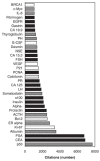A list of candidate cancer biomarkers for targeted proteomics
- PMID: 19690635
- PMCID: PMC2716785
A list of candidate cancer biomarkers for targeted proteomics
Abstract
We have compiled from literature and other sources a list of 1261 proteins believed to be differentially expressed in human cancer. These proteins, only some of which have been detected in plasma to date, represent a population of candidate plasma biomarkers that could be useful in early cancer detection and monitoring given sufficiently sensitive specific assays. We have begun to prioritize these markers for future validation by frequency of literature citations, both total and as a function of time. The candidates include proteins involved in oncogenesis, angiogenesis, development, differentiation, proliferation, apoptosis, hematopoiesis, immune and hormonal responses, cell signaling, nucleotide function, hydrolysis, cellular homing, cell cycle and structure, the acute phase response and hormonal control. Many have been detected in studies of tissue or nuclear components; nevertheless we hypothesize that most if not all should be present in plasma at some level. Of the 1261 candidates only 9 have been approved as "tumor associated antigens" by the FDA. We propose that systematic collection and large-scale validation of candidate biomarkers would fill the gap currently existing between basic research and clinical use of advanced diagnostics.
Keywords: biomarkers; cancer; targeted proteomics; validation.
Figures









References
-
- Abe H, Kuroki M, Imakiire T, et al. Preparation of recombinant MK-1/Ep-CAM and establishment of an ELISA system for determining soluble MK-1/Ep-CAM levels in sera of cancer patients. J Immunol Methods. 2002;270:227–33. - PubMed
-
- Acs G, Acs P, Beckwith SM, et al. Erythropoietin and erythropoietin receptor expression in human cancer. Cancer Res. 2001;61:3561–5. - PubMed
-
- Adler HL, McCurdy MA, Kattan MW, et al. Elevated levels of circulating interleukin-6 and transforming growth factor-beta1 in patients with metastatic prostatic carcinoma. J Urol. 1999;161:182–7. - PubMed
-
- Adrian TE, Besterman HS, Mallinson CN, et al. Plasma trypsin in chronic pancreatitis and pancreatic adenocarcinoma. Clin Chim Acta. 1979;97:205–12. - PubMed
-
- Afzal S, Ahmad M, Mushtaq S, et al. Morphological features correlation with serum tumour markers in prostatic carcinoma. J Coll Physicians Surg Pak. 2003;13:511–4. - PubMed
LinkOut - more resources
Full Text Sources
Other Literature Sources
Miscellaneous
